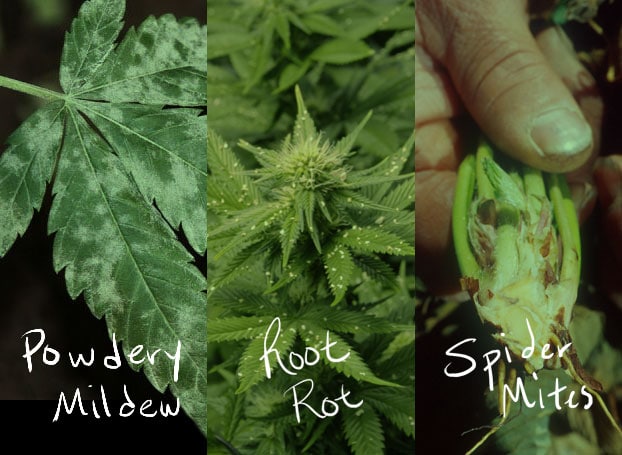
If you are growing marijuana in Colorado, then you should already know all about powdery mildew. Powdery mildew is a fungal disease that appears in the form of a white powdery spore. If left unchecked, it can devour you entire marijuana crop. But don’t despair, here are some methods for powdery mildew treatment.
Identifying powdery mildew
Inhaling powdery mildew isn’t safe and can lead to respiratory infection, bronchitis and long term problems like COPD. Fortunately, identifying and treating powdery mildew is easy. With a little bit of diligence, you’ll have no problem keeping your marijuana garden clean. Once you see powdery mildew, you will find it hard to forget. It is distinctly out of place on a rich green marijuana plant. Normally a frosty layer on your cannabis is good, but not this time. When you see trichrome on a bud, it is a crystal. It glistens like sugar. Powdery mildew on the other hand, looks like baking flour. In contrast with the cannabis, on which it now resides, it’s kind of hard to miss.
The problem with powdery mildew
If the infestation is really bad, the slightest touch will send a cloud of spores into the air. Our ventilation systems are designed to circulate the air, and replace the old with the new. Powdery mildew takes advantage of this and uses the constantly flowing currents of air to travel from plant to plant. Once it starts, you need to act fast in order to prevent it from spreading. Sometimes, powdery mildew will pop up in just one area of your grow. If it happens over and over, but stays in one spot, you might have a leaky A/C or water dripping in from somewhere else. Often times, powdery mildew is caused by contamination. Carrying spores into your garden by walking through the weeds outside is probably something that happens everyday. Powdery mildew loves moisture. High temperatures and just slightly above normal humidity and you have a hotbed of potential fungal activity on your hands.
Powdery mildew treatment: plan A
Maintaining a proper environment is always fundamental, but it is especially vital in preventing powdery mildew from ruining your crop. Once you have your environment dialed in, there are a number of powdery mildew treatment solutions that will kill spores and prevent new ones from taking hold. Manual removal is a great way to remove powdery mildew on the surface of the leaves. Removing the affected areas is the right place to start, but make sure to glove-up and wear a simple filter mask. After you’re done you’ll want to treat your crop with a foliar spray, unless you are absolutely confident you’ve eradicated the problem. An application of neem oil, commonly sold as azadirachtin, works as a broad spectrum fungicide. It is an ingredient in many ORMI certified products, so its use still qualifies as organic. Harvested from the seeds of a unique breed of evergreen tree, azadirachtin works by coating the spores and dehydrating them. It fundamentally ends the cycle of life and is a safe alternative to some of the more harsh commercial alternatives. A light spray once a week will kick your pm problem, usually in less than a month.
Powdery mildew treatment: plan B
Another powdery mildew treatment is a hydrogen dioxide solution that is commercially available under a variety of brands. Hydrogen Dioxide, or H2O2, sounds scarier than it is. Another certified organic product, hydrogen dioxide is a highly concentrated form of the stuff you used to pour on cuts as a kid. In a diluted solution, it’s safe to apply as much as you want right up until the day before harvest. In it’s concentrated form it can be harsh to the skin, so always use protection when crafting your mixture. The bottom line: just because you see some powdery mildew spring up in your cannabis garden, it’s not the end of the world. Just be proactive about your powdery mildew treatment and be mindful that it can be just as harmful to the grower as it can be to your marijuana harvest.
Have you experienced powdery mildew, what did you “dew” about it? Let us know on social media.







hi there, I strongly disagree about neem oil, it can clog the leaves and keep them from breathing properly. there’s a Lot of other treatments that do a better job, also you have no mention of a sulphur burner to kill all the spores in the room. just spraying the leaves if its indoor won’t totally get rid of the pm, but a 2-3 hour sulphur burn with the lights off will.